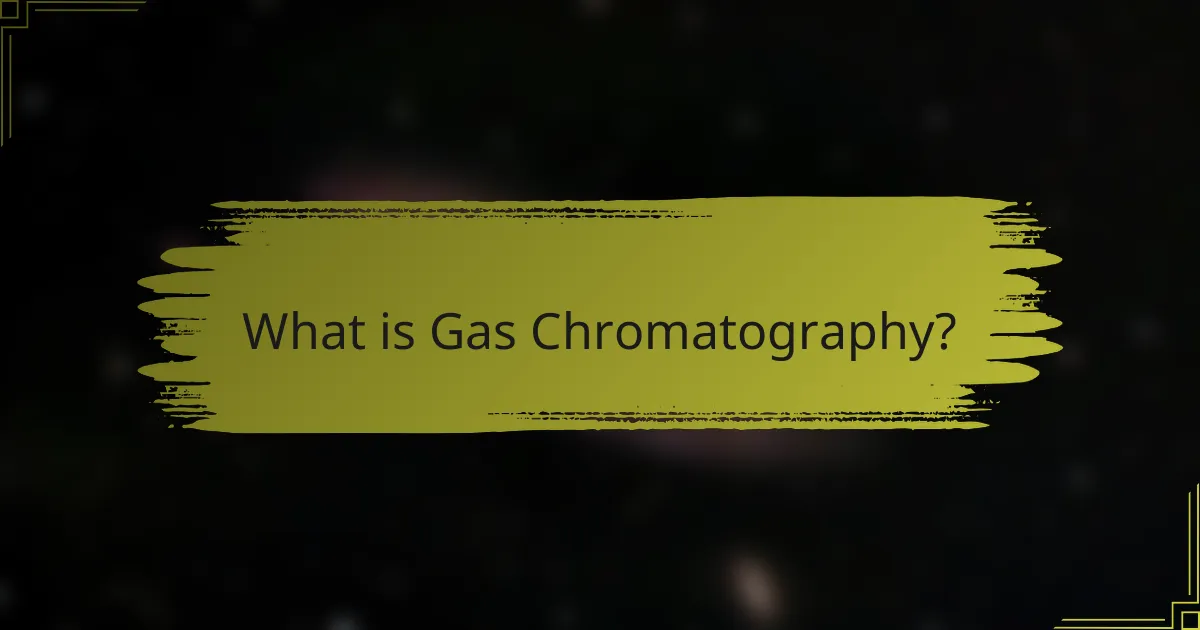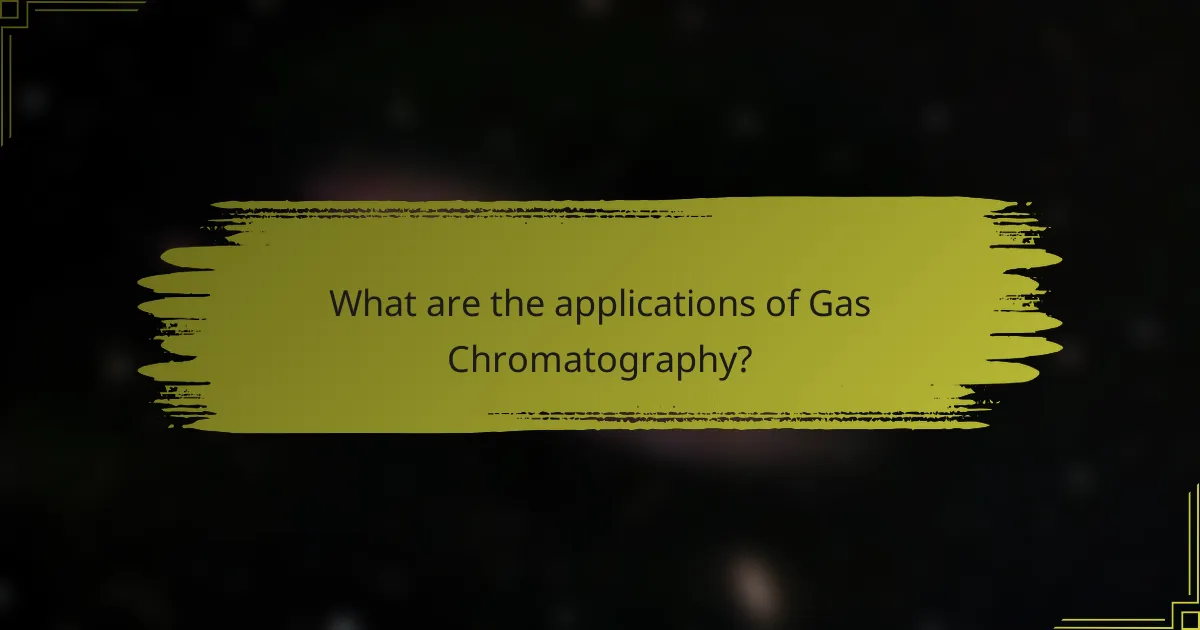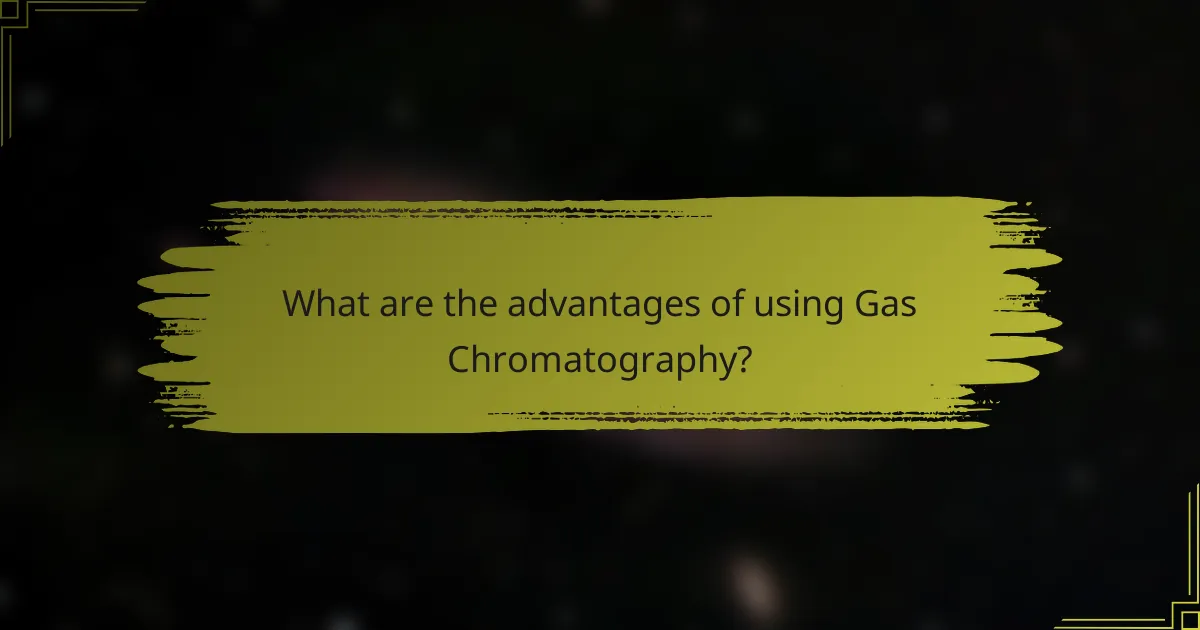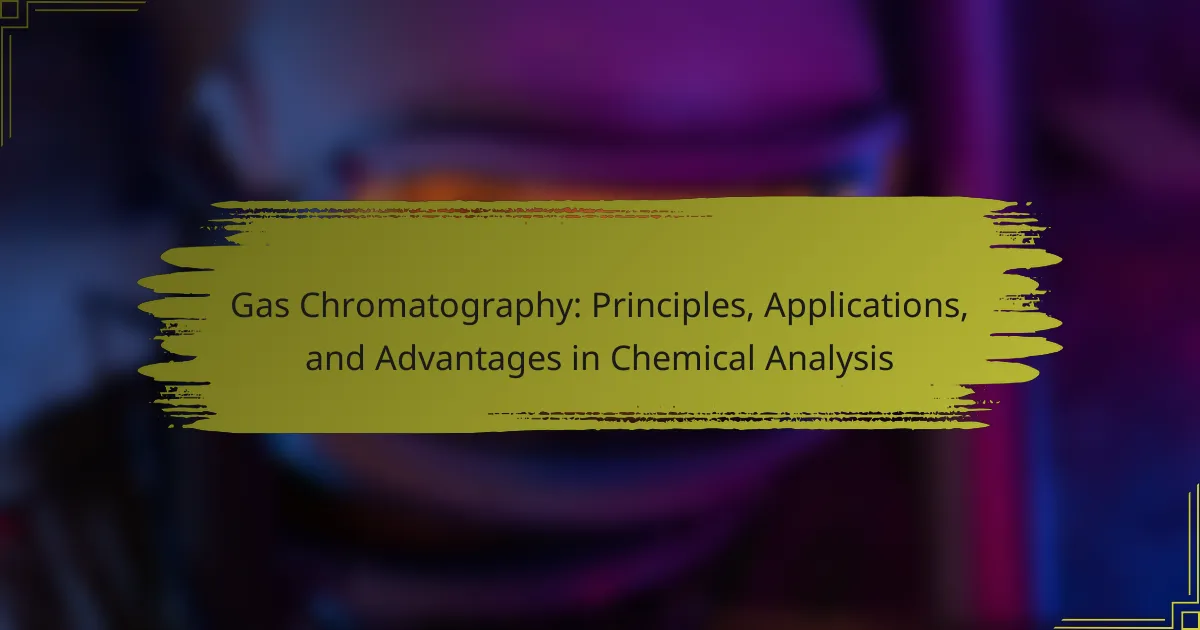
What is Gas Chromatography?
Gas chromatography is an analytical technique used to separate and analyze compounds in a mixture. It involves vaporizing the sample and passing it through a column filled with a stationary phase. The different components of the mixture travel at varying speeds, leading to separation. This method is widely used in chemistry and biochemistry for quantitative and qualitative analysis. Gas chromatography can identify volatile substances, making it essential in fields like environmental testing and food safety. Its effectiveness is supported by its ability to provide high-resolution separation and rapid analysis times.
How does Gas Chromatography operate?
Gas chromatography operates by separating volatile compounds in a sample based on their affinity for a stationary phase and a mobile phase. The process begins with a sample being vaporized and introduced into a carrier gas stream. This carrier gas transports the sample through a column coated with a stationary phase. As the sample moves through the column, different components interact with the stationary phase to varying degrees. This interaction causes the components to separate based on their respective retention times. The separated components are then detected as they exit the column, typically using a detector such as a flame ionization detector (FID). This method allows for precise analysis of complex mixtures due to its high resolution and sensitivity.
What are the key components of a Gas Chromatography system?
The key components of a Gas Chromatography system include the injector, column, detector, and data acquisition system. The injector introduces the sample into the system. The column separates the components of the sample based on their volatility. The detector identifies and quantifies the separated components as they exit the column. The data acquisition system records the detector’s responses and generates a chromatogram. Each component plays a crucial role in the overall function of the Gas Chromatography system, ensuring accurate analysis of chemical mixtures.
How does the separation process occur in Gas Chromatography?
The separation process in Gas Chromatography occurs through the partitioning of compounds between a stationary phase and a mobile gas phase. The sample mixture is vaporized and introduced into the column containing the stationary phase. As the mobile phase carries the vaporized sample through the column, different compounds interact with the stationary phase to varying degrees. This interaction is based on each compound’s volatility and affinity for the stationary phase. Compounds that interact more strongly with the stationary phase move slower, while those with weaker interactions elute faster. The result is the separation of components based on their retention times. This method is widely used in analytical chemistry for its effectiveness in separating complex mixtures.
What are the fundamental principles of Gas Chromatography?
Gas chromatography (GC) is a method used to separate and analyze compounds in a gaseous state. The fundamental principles of GC involve the partitioning of analytes between a stationary phase and a mobile gas phase. The stationary phase is typically a liquid or solid coated onto a column. The mobile phase is an inert gas that carries the sample through the column.
As the sample vaporizes, components interact differently with the stationary phase. This interaction leads to varying retention times for each component. Components that interact more strongly with the stationary phase will take longer to exit the column. Conversely, those with weaker interactions will elute faster.
The separation of components is detected by a detector at the column’s end. Common detectors include flame ionization and thermal conductivity detectors. The output is a chromatogram, which displays peaks corresponding to different components. Each peak’s area is proportional to the amount of the respective component in the sample.
These principles enable accurate qualitative and quantitative analysis of complex mixtures. Gas chromatography is widely used in various fields, including environmental monitoring and pharmaceuticals.
How do temperature and pressure influence Gas Chromatography?
Temperature and pressure significantly influence Gas Chromatography (GC) performance. Higher temperatures generally lead to increased vaporization of analytes. This results in faster elution times and improved separation efficiency. Elevated temperatures can also reduce viscosity and enhance mass transfer in the column. Conversely, lower temperatures can improve resolution but may prolong analysis time.
Pressure affects the flow rate of the carrier gas. Increased pressure can enhance the speed of analyte transport through the column. However, excessive pressure can lead to peak broadening and decreased resolution. Optimal temperature and pressure settings are crucial for achieving reliable and reproducible results in GC.
What role does the stationary phase play in Gas Chromatography?
The stationary phase in Gas Chromatography is crucial for separating components of a mixture. It is a solid or liquid that remains fixed inside the column. As the mobile phase carries the sample, different components interact with the stationary phase to varying degrees. This interaction leads to differences in retention times for each component. The stationary phase’s properties, such as polarity and thickness, directly influence separation efficiency. Studies show that optimizing the stationary phase can enhance resolution and sensitivity in analyses. Therefore, the stationary phase is essential for effective separation in Gas Chromatography.

What are the applications of Gas Chromatography?
Gas chromatography is widely used for separating and analyzing compounds in various fields. Its applications include environmental testing, where it detects pollutants in air, soil, and water. In the pharmaceutical industry, gas chromatography is crucial for analyzing drug compositions and purity. Food safety testing also relies on this technique to identify contaminants and verify ingredient authenticity. Additionally, gas chromatography is utilized in forensic science for analyzing substances in criminal investigations. The petrochemical industry uses it for quality control of fuels and oils. These applications demonstrate gas chromatography’s versatility and importance across multiple sectors.
In which industries is Gas Chromatography commonly used?
Gas Chromatography is commonly used in the pharmaceutical, environmental, food and beverage, petrochemical, and forensic industries. In the pharmaceutical industry, it ensures the purity and concentration of active ingredients. Environmental monitoring utilizes it to analyze pollutants in air, water, and soil. The food and beverage sector employs Gas Chromatography to detect additives and contaminants. In petrochemicals, it helps in characterizing complex mixtures of hydrocarbons. Forensic science uses this technique to analyze substances in criminal investigations. These applications underscore the versatility and importance of Gas Chromatography across various sectors.
How is Gas Chromatography applied in environmental analysis?
Gas chromatography is applied in environmental analysis to detect and quantify pollutants in various matrices. It separates volatile compounds from air, water, and soil samples. The technique is crucial for monitoring contaminants like pesticides, heavy metals, and volatile organic compounds. By using specific detectors, it can identify trace amounts of these substances. Studies show that gas chromatography can achieve detection limits in the parts per billion range. This precision is essential for regulatory compliance and environmental protection. Additionally, it helps in assessing the effectiveness of remediation efforts. Overall, gas chromatography is a vital tool in environmental monitoring and assessment.
What role does Gas Chromatography play in pharmaceutical development?
Gas Chromatography (GC) plays a critical role in pharmaceutical development. It is primarily used for the analysis of volatile compounds in drug formulations. GC enables the separation and quantification of complex mixtures. This precision is essential for ensuring the quality and safety of pharmaceuticals. Furthermore, GC assists in the identification of impurities and degradation products. The method is highly sensitive and can detect trace levels of substances. Regulatory agencies often require GC data for drug approval processes. Overall, GC is vital for maintaining pharmaceutical standards and compliance.
What types of samples can be analyzed using Gas Chromatography?
Gas chromatography can analyze a variety of sample types. These include gases, liquids, and volatile compounds. Common samples are essential oils, pesticides, and food flavorings. Environmental samples like air and water also fit this method. Biological samples, such as blood and urine, can be analyzed too. The technique is effective for separating complex mixtures. It is widely used in quality control and research.
How does Gas Chromatography handle volatile and semi-volatile compounds?
Gas Chromatography (GC) effectively separates volatile and semi-volatile compounds by utilizing a stationary phase and a mobile phase. The sample is vaporized and injected into a column containing the stationary phase. As the sample moves through the column with the mobile phase, different compounds interact with the stationary phase to varying degrees. This interaction leads to differential retention times for each compound. Volatile compounds typically elute faster due to their lower boiling points. Semi-volatile compounds have higher boiling points, resulting in longer retention times. The separation is based on the volatility and polarity of the compounds in the sample. This method allows for precise identification and quantification of complex mixtures.
What sample preparation methods are used for Gas Chromatography?
Sample preparation methods for Gas Chromatography include liquid-liquid extraction, solid-phase extraction, and headspace analysis. Liquid-liquid extraction separates compounds based on their solubility in different liquids. Solid-phase extraction uses a solid adsorbent to isolate analytes from a solution. Headspace analysis involves sampling the vapor above a solid or liquid sample. These methods enhance the sensitivity and specificity of the analysis. Each technique is chosen based on the sample matrix and target analytes. Proper sample preparation is crucial for accurate results in Gas Chromatography.

What are the advantages of using Gas Chromatography?
Gas Chromatography (GC) offers several advantages in chemical analysis. It provides high sensitivity, allowing for the detection of trace amounts of substances. GC also delivers quick analysis times, often completing separations in minutes. The technique is highly reproducible, ensuring consistent results across multiple runs. Additionally, GC can analyze a wide range of samples, including gases and volatile liquids. It requires minimal sample preparation, which streamlines the process. The method is also capable of separating complex mixtures effectively. These advantages make GC a preferred choice in various fields, including environmental testing and pharmaceuticals.
What benefits does Gas Chromatography provide over other analytical methods?
Gas Chromatography (GC) offers several benefits over other analytical methods. It provides high sensitivity and can detect trace levels of compounds. GC also has a rapid analysis time, often completing separations in minutes. The method is highly reproducible, ensuring consistent results across multiple tests. GC is effective for volatile and semi-volatile compounds, making it suitable for a wide range of applications. Additionally, it requires minimal sample preparation compared to other techniques like High-Performance Liquid Chromatography (HPLC). GC also allows for the analysis of complex mixtures with high resolution. These advantages make GC a preferred choice in various fields, including environmental analysis and quality control in the pharmaceutical industry.
How does Gas Chromatography ensure accuracy and precision?
Gas Chromatography ensures accuracy and precision through controlled temperature and pressure conditions. The method utilizes a stationary phase and a mobile phase for separation. Each component of a mixture interacts differently with the stationary phase. This differential interaction leads to distinct retention times for each substance. Accurate calibration with standards enhances measurement reliability. Precision is achieved through repeatable results across multiple runs. High-resolution detectors, such as mass spectrometers, further improve identification and quantification. These features collectively contribute to the method’s robustness in chemical analysis.
What are the cost-effectiveness aspects of Gas Chromatography?
Gas Chromatography (GC) is cost-effective due to its high efficiency and low operational costs. It requires minimal sample preparation, reducing labor and time expenses. GC instruments have a long lifespan, which decreases the need for frequent replacements. The technique also allows for the analysis of multiple samples simultaneously, maximizing throughput. Moreover, the high sensitivity of GC reduces the amount of sample needed, lowering material costs. The automation capabilities of modern GC systems further enhance productivity while minimizing human error. Overall, these factors contribute to a favorable return on investment in laboratory settings.
What challenges or limitations exist in Gas Chromatography?
Gas chromatography faces several challenges and limitations. One major challenge is the need for sample preparation. Complex matrices can interfere with accurate analysis. Another limitation is the potential for thermal degradation of samples. High temperatures can alter the chemical composition of sensitive compounds. Additionally, gas chromatography has a limited ability to separate complex mixtures. This can lead to co-elution of analytes, complicating results. Furthermore, the technique requires expensive equipment and maintenance. The costs can be prohibitive for smaller laboratories. Lastly, gas chromatography is less effective for polar or high molecular weight compounds. These limitations can restrict its applicability in certain analytical scenarios.
How can common issues in Gas Chromatography be resolved?
Common issues in Gas Chromatography can be resolved through several methods. First, ensure proper column installation and maintenance. This prevents leaks and ensures consistent flow rates. Second, regularly calibrate the instrument to maintain accuracy. Calibration can help identify and correct deviations in results. Third, optimize the temperature program to improve separation efficiency. Adjusting the temperature can reduce retention time and enhance peak resolution. Fourth, use appropriate carrier gases to ensure optimal performance. The choice of gas affects sensitivity and resolution. Finally, perform routine system checks for contamination or damage. Regular maintenance can prevent many common issues from arising.
What best practices should be followed when using Gas Chromatography?
Ensure proper calibration of the gas chromatography instrument before use. Regular calibration enhances accuracy and reliability in results. Maintain a clean and well-organized workspace to prevent contamination. Contaminated samples can lead to erroneous data. Use high-quality reagents and standards to ensure the integrity of the analysis. Quality materials minimize variability in results. Optimize the temperature program for the specific analysis being conducted. Proper temperature settings improve separation efficiency. Monitor the flow rate of the carrier gas consistently. Consistent flow rates are crucial for reproducibility. Regularly inspect and maintain the column and injector for signs of wear. Well-maintained equipment ensures consistent performance. Document all procedures and results meticulously. Accurate records facilitate troubleshooting and validation of results.
Gas chromatography is an analytical technique used for the separation and analysis of volatile compounds in mixtures. This article covers the principles of gas chromatography, including its operational mechanisms, key components, and the separation process based on interactions between stationary and mobile phases. Additionally, it explores the various applications of gas chromatography in fields such as environmental testing, pharmaceuticals, and food safety, highlighting its advantages, cost-effectiveness, and challenges. The article also provides insights into best practices for effective use and common issue resolution within gas chromatography systems.
